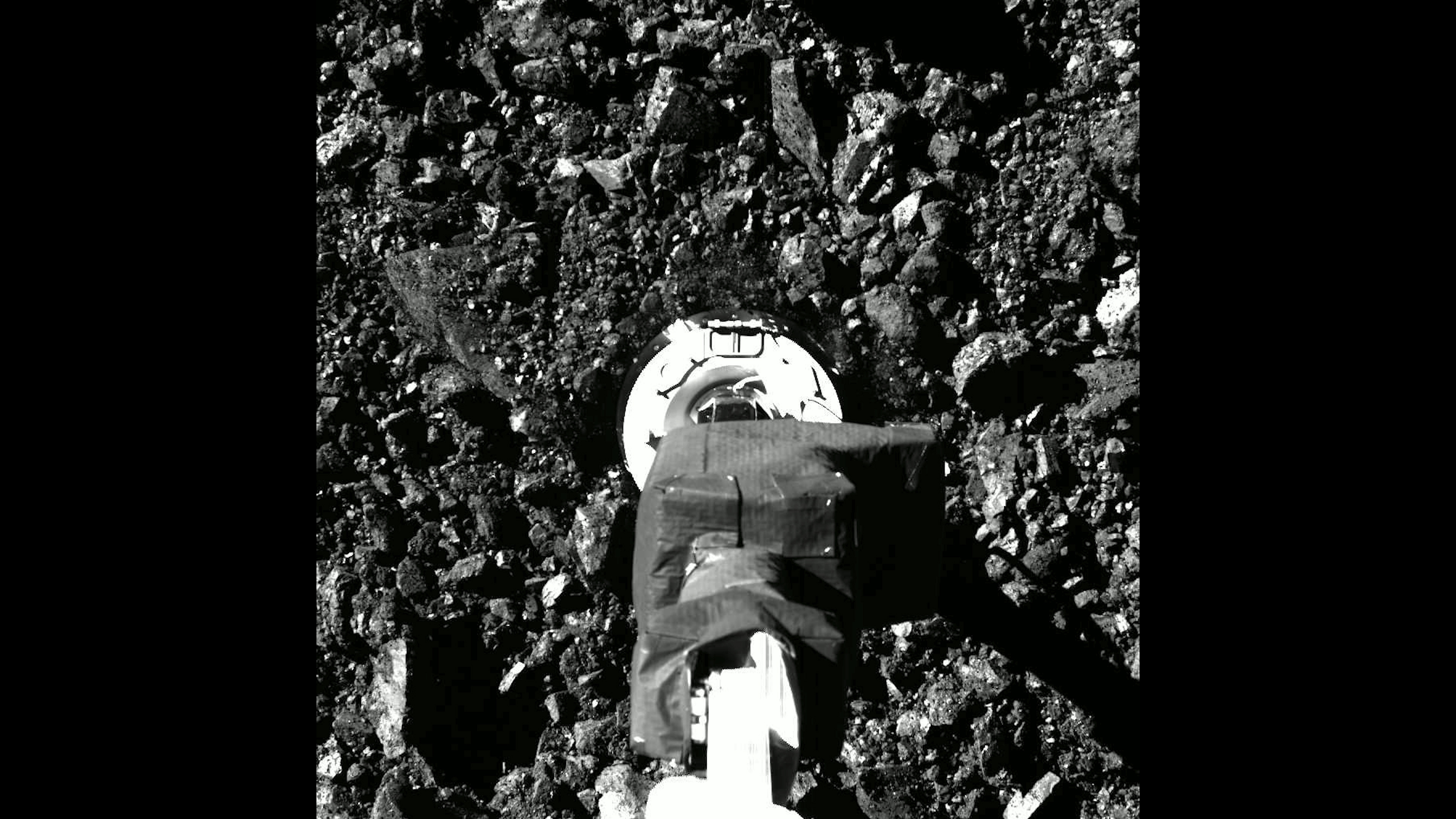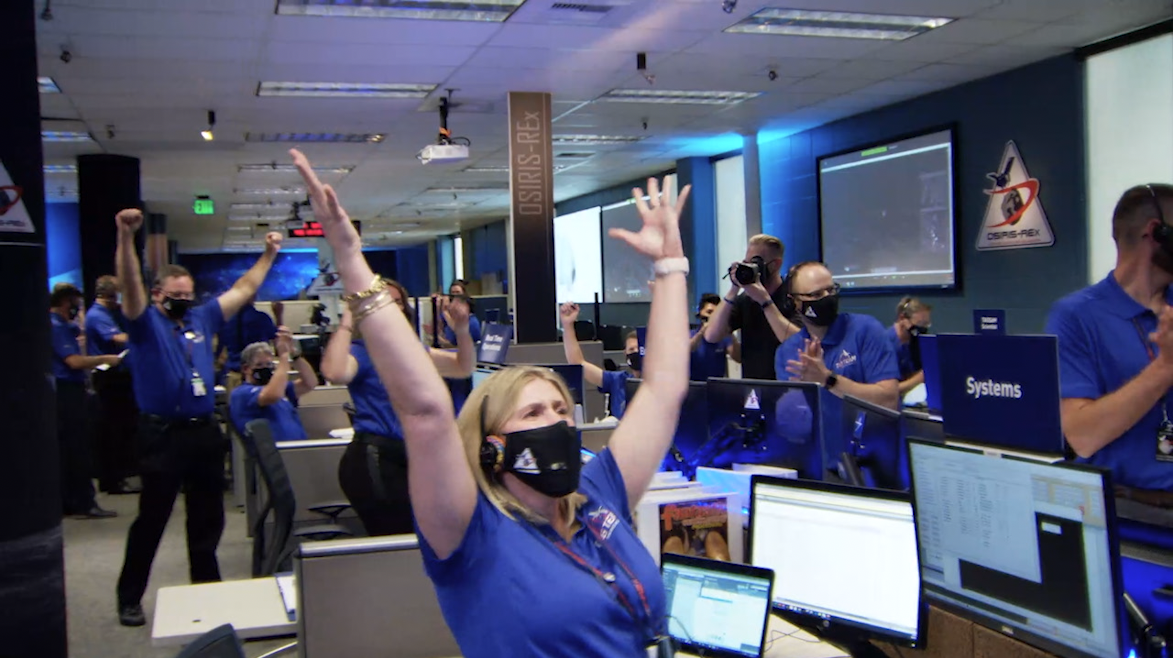OSIRIS-REx Science and Engineering Briefing

Main title for T-1 OSIRIS-REx Science and Engineering Briefing
NASA is hosting a media teleconference at 3 p.m. EDT Monday, Oct. 20, to provide an update on the agency’s first attempt to contact the surface of asteroid Bennu and collect a sample.
The Origins, Spectral Interpretation, Resource Identification, Security-Regolith Explorer (OSIRIS-REx) spacecraft will travel to the asteroid’s surface during its first sample collection attempt Oct. 20. Its sampling mechanism will touch Bennu’s surface for several seconds, fire a charge of pressurized nitrogen to disturb the surface, and collect a sample before the spacecraft backs away.
Participating in this mission update are:
• Thomas Zurbuchen, associate administrator of NASA’s Science Mission Directorate
• Lori Glaze, director of NASA's Planetary Science Division
• Heather Enos, OSIRIS-REx deputy principal investigator, University of Arizona, Tucson
• Kenneth Getzandanner, OSIRIS-REx flight dynamics manager, Goddard
• Beth Buck, OSIRIS-REx mission operations program manager, Lockheed Martin Space, Littleton, Colorado
For more information, go to nasa.gov/osiris-rex or asteroidmission.org
1. Intro to Briefing: Excerpt of Challenges of TAG
Music is "Avenger" by Max Cameron Concors of Universal Production Music.

1. Zurbuchen - OSIRIS-REx Overview
Top Left: OSIRIS-REx Launching from Cape Canaveral Air Force Station aboard a United Launch Alliance Atlas V 411 rocket on September 8, 2016 at 7:05 pm EDT.
Top Right: Image of Bennu was taken by the OSIRIS-REx spacecraft.
Center: Image of sample site Nightingale Crater, OSIRIS-REx’s primary sample collection site on asteroid Bennu, overlaid with a graphic of the OSIRIS-REx spacecraft to illustrate the scale of the site.
Bottom Left: Image of OSIRIS-REx’s SamCam imager’s field of view as the NASA spacecraft approaches asteroid Bennu’s surface, taking during the second dress rehearsal for sample collection on August 11, 2020.
Bottom Center: Illustration of trajectory and configuration of NASA’s OSIRIS-REx spacecraft during Checkpoint rehearsal, which was the first time the mission practiced the initial steps of collecting a sample from asteroid Bennu.
Bottom Right: Image of Sierra Gonzalez, Lockheed Martin Systems Engineer, taken April 14, 2020 during the four-hour rehearsal of the Checkpoint maneuver in which OSIRIS-REx came within 125 meters (410 feet) of Bennu’s surface.
Credits: NASA/Goddard/University of Arizona/ Lockheed Martin/United Launch Alliance

1. Glaze - Asteroid missions and sample return
Top Left: Apollo sample processors (from left to right) Andrea Mosie, Charis Krysher and Juliane Gross open lunar sample 73002 at NASA's Johnson Space Center in Houston. The Moon rocks inside this tube have remained untouched since they were collected on the surface and brought to Earth by Apollo astronauts nearly 50 years ago.
Top Right: Scientist-astronaut Harrison H. Schmitt, Apollo 17 lunar module pilot, collects lunar rake samples at Station 1 during the mission's first spacewalk at the Taurus-Littrow landing site.
Center: Illustration showing NASA’s OSIRIS-REx spacecraft descending towards asteroid Bennu to collect a sample of the asteroid’s surface.
Bottom Left: Illustration of NASA’s DART spacecraft prior to impact at the Didymos binary system.
Bottom Center: Illustration of NASA’s Lucy spacecraft performing a flyby of a Jupiter Trojan.
Bottom Right: Illustration of NASA’s Psyche Spacecraft with Five-Panel Array.
Credits: NASA/Goddard/JPL-Caltech / Arizona State University/University of Arizona/Johns Hopkins APL/Space Systems Loral/James Blair/Steve Gribben/Peter Rubin

1. Enos - Bennu Pyramid
Credit: NASA/Goddard/University of Arizona

2. Enos - Sample Site Nightingale
Credit: NASA/Goddard/University of Arizona
3. Enos - Nightingale Up Close
Credit: NASA/Goddard/SVS
1. Getzandanner - OSIRIS-REx Orbit Maneuvers
Data provided by NASA/University of Arizona/CSA/York University/MDA
Credit: NASA/Goddard/SVS

2. Getzandanner - OSIRIS-REx Lowest Altitudes
Credit: NASA/Goddard/University of Arizona
3. Getzandanner - OSIRIS-REx Imagery of Asteroid Bennu
Credit: NASA/Goddard/University of Arizona
4. Getzandanner - TAG Orbit Maneuvers
Data provided by NASA/University of Arizona/CSA/York University/MDA
Credit: NASA/Goddard/SVS
5. Getzandanner - Sample Site Nightingale Hazard Map
Data provided by NASA/University of Arizona/CSA/York University/MDA
Credit: NASA/Goddard/SVS
1. Buck - MSA during MatchPoint Rehearsal
Credit: Lockheed Martin
2. Buck - Spacecraft POV of TAG
Data provided by NASA/University of Arizona/CSA/York University/MDA
Credit: NASA/Goddard/SVS
3. Buck - TAGSAM Explained
OSIRIS-REx descends to the surface of asteroid Bennu to collect a sample of fine-grained material from site Nightingale using its TAGSAM instrument.
Credit: NASA/Goddard/CI Lab
4. Buck - Initiating NFT and Descent to Nightingale
Credit: NASA/Goddard/CI Lab
5. Buck - Nightingale Sampling Area to Scale
This artist concept animation shows a size comparison of the planned sample collection area before arriving at Bennu (orange), and after arriving at Bennu (blue). The original mission plan envisioned a sample site with a diameter of 164 feet (50 m). However, the sampling region for site Nightingale is approximately 26 ft (8 m) in diameter. The area safe enough for the spacecraft to touch is the width of a few parking spaces.
Credit: NASA/Goddard/CI Lab
6. Buck - TAG "What If?" Scenario - Descent onto a Hazard
During its descent to site Nightingale, OSIRIS-REx could encounter several hazardous scenarios that would prevent it from collecting a sample of asteroid Bennu on its first attempt, including: Wave-Off, TAG on a boulder, and TAG on rocks.
Credit: NASA/Goddard/CI Lab
7. Buck - TAG Sequence
OSIRIS-REx makes its descent to Nightingale and collects a sample using its TAGSAM collector head.
Credit: NASA/Goddard/CI Lab
For More Information
See the following sources:
Credits
Please give credit for this item to:
NASA's Goddard Space Flight Center
-
Public affairs officer
- Nancy Neal-Jones (NASA/GSFC)
-
Presenters
- Nancy Neal-Jones (NASA/GSFC)
- Thomas H. Zurbuchen (NASA/HQ)
- Lori S. Glaze (NASA/HQ Planetary Science)
- Kenny Getzandanner (NASA/GSFC)
- Heather Enos (University of Arizona)
- Beth Buck (Lockheed Martin)
-
Producers
- James Tralie (ADNET Systems, Inc.)
- Dan Gallagher (USRA)
-
Graphic designers
- Heather Roper (The University of Arizona)
- Joshua Handal (ASRC Federal System Solutions)
-
Animators
- Walt Feimer (KBR Wyle Services, LLC)
- Michael Lentz (USRA)
- Adriana Manrique Gutierrez (USRA)
- Bailee DesRocher (USRA)
- Jacquelyn DeMink (USRA)
- Jonathan North (USRA)
- Lisa Poje (Freelance)
-
Data visualizer
- Kel Elkins (USRA)
-
Support
- Erin Morton (The University of Arizona)
- Aaron E. Lepsch (ADNET Systems, Inc.)
Release date
This page was originally published on Monday, October 19, 2020.
This page was last updated on Wednesday, May 3, 2023 at 1:44 PM EDT.

